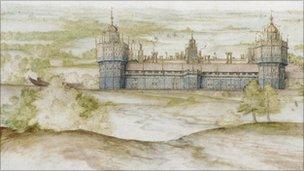Nonsuch Palace painting fails to sell at auction
- Published

How Nonsuch Palace looked is now known only by written records and paintings
A detailed depiction of Henry VIII's "lost" palace has failed to meet its reserve price at auction.
Nonsuch Palace - named because no other palace could equal it - was built for the Tudor king to celebrate the birth of his first legitimate son.
Construction of the site in Cuddington, near Epsom, Surrey, began in 1538 but it fell into disrepair in the 17th Century and nothing now remains.
Joris Hoefnagel's watercolour had been expected to fetch up to £1.2m.
Henry VIII wanted Nonsuch to outshine the great palaces built by his rival, King Francis I of France.
The parish church of Cuddington was flattened to make way for it, in a demonstration of Henry's new dominance as head of the Church of England.
'Immense beauty'
It was still incomplete when Henry died in 1547 and fell into disrepair in the 1680s. By 1690 it was all but gone.
The 1568 watercolour is said by Christie's to be the earliest and most detailed depiction of the palace.
Benjamin Peronnet, head of Old Master and 19th Century drawings at Christie's, said it was the most important depiction of the palace.
"Not only is it one of the earliest British watercolours and a work of art of immense beauty, but it is also the most exact pictorial record of Henry VIII's great commission," he said.
"Nonsuch Palace stood for less than 150 years and there are only four contemporary depictions that are known to survive.
"Of these, the watercolour is the earliest, and the only one to show a true impression of the 'lost' palace."
- Published3 November 2010